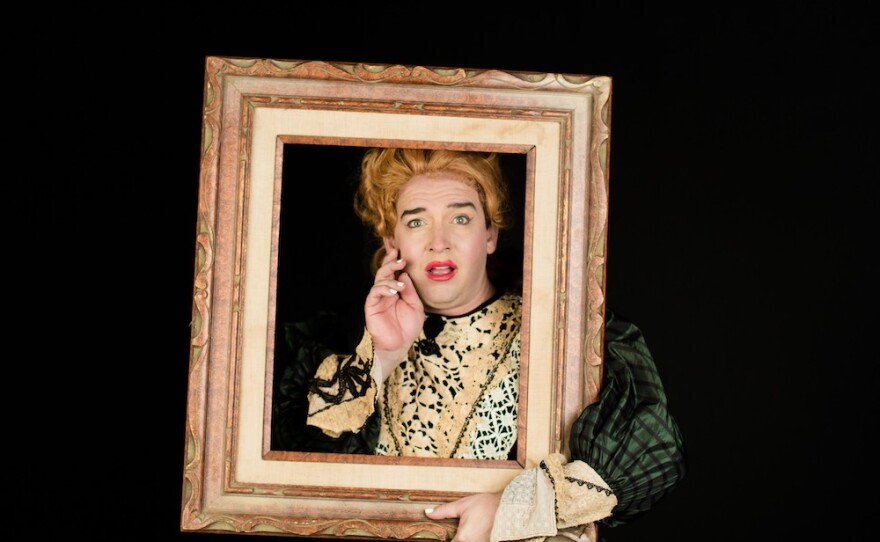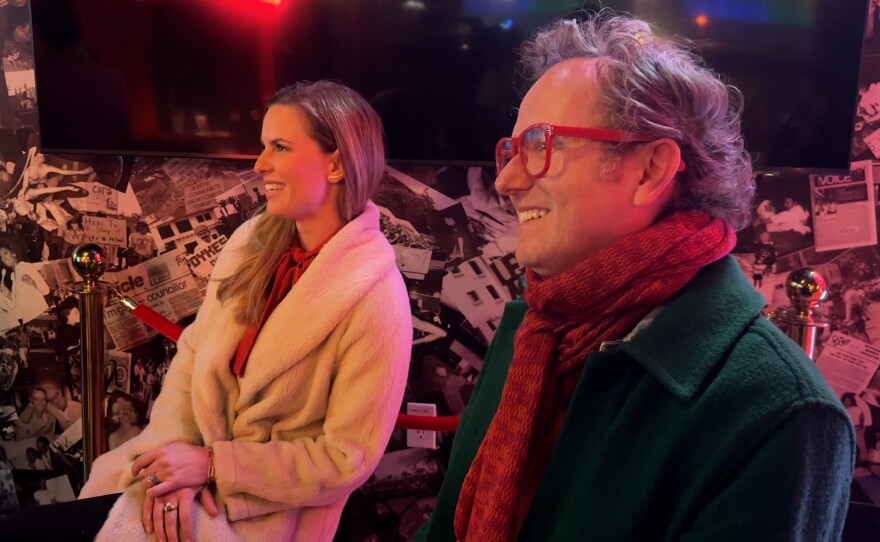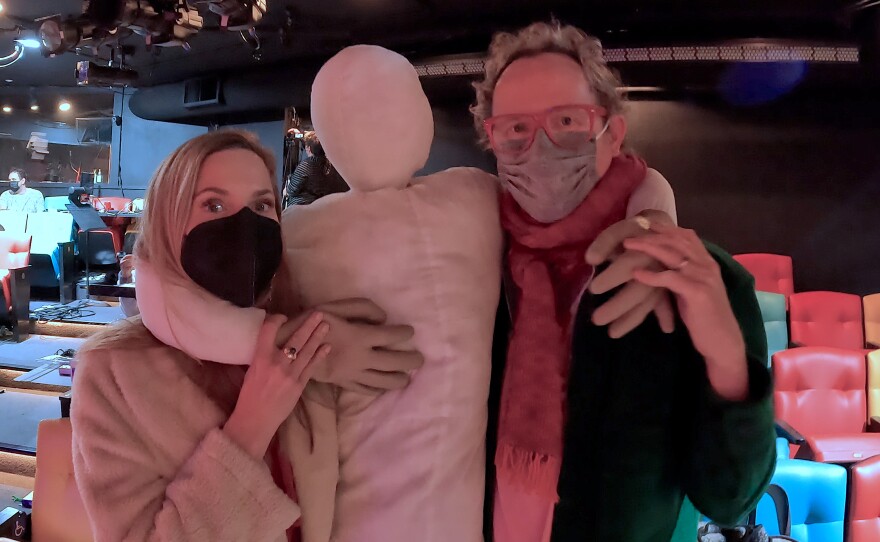Diversionary Theatre is avoiding the obvious holiday classics to stage something that brings a different kind of joy: Charles Ludlam’s 1984 play "The Mystery of Irma Vep."

Who is Irma Vep?
There’s a mystery to be solved at Diversionary Theatre and it revolves around who is Irma Vep?
The play's co-director Allison Spratt Pearce gave a pragmatic answer: "Irma Vep is a character in the show. She was a woman that was married to one of our characters and she has died."
But actor Luke Harvey Jacobs was more elliptical: "Irma Vep is a mystery wrapped in a conundrum. I'm Irma Vep, you're Irma Vep. We're all Irma Vep."
Co-director Matt Morrow offered this response: "Irma Vep is a legend, an idea. She wasn't a vampire. Even though Irma Vep is an anagram for vampire. She was a master of disguise. So I think Irma Vep is sort of the central idea behind the show that we can never truly know one another."
And dramaturg Jesse Marchese concluded: "Irma Vep is so many different things. Irma Vep is a shapeshifter. Irma Vep is a metaphor. Irma Vep is the monster in our closet that sort of haunts us all, but I think also motivates us to do things for the ones we love."
But in the play, Irma Vep is also the MacGuffin, something that triggers a plot but then turns out to be sort of irrelevant. It’s a term coined by Alfred Hitchcock and "The Mystery of Irma Vep" draws inspiration from Hitchcock’s film "Rebecca" plus a host of other sources.
As dramaturg, it was Marchese job to explore what all those sources were.
"This is a play that references a ton of classic works of literature and pieces of pop culture," Marchese explained. "But there's also these little snippets of dialogue that come from more obscure sources like b-movies, old Hollywood movies, Penny Dreadfuls, which were these old Victorian horror stories that came out weekly and you paid a penny for them and pulp adventure and horror stories."
That diverse mixture was irresistible to Diversionary artistic director Matt Morrow.
"All of this is sort of mashed up and swirled into this delightful macabre story that is outrageous and utterly hilarious," Morrow said.

Two actors, 35 roles
"Everyone needs to see something ridiculous," Pearce added about the play. "And that is what Charles Ludlam created for us, something absurd and ridiculous."
Playwright Ludlam also created the play as a showcase for two actors who have to perform 35 roles.
"I play the lady of the house, and I also play the stable boy," explained actor Jacobs. "So you really can't get more incongruous than that but then you might find they have more in common than just the actor playing them."
Jacobs represents 50% of the cast. He’s required to execute dozens of costume and character changes in mere seconds so the behind the scenes shenanigans are as delightful for the audience as the ripe onstage melodrama.
"Twenty minutes in, they'll be like, wait, that person was just this person, and this person was just that person, and their heads will be spinning, and that's exactly what we want," Jacobs said.

That’s what co-director Pearce was fine tuning at the tech rehearsal on Wednesday.
"This whole show is the art of the quick change," Pearce said. "So they have 10 seconds to switch characters, switch energies, switch shape, switch dialects."
But it’s not just the actors that morph, it’s also the set.

"I don't want to give away any secrets, but pretty much every piece of it does something surprising," Morrow stated. "So our design concept was to sort of mash up Dr. Caligari (a German expressionist silent film) and Pee-Wee's Playhouse, so we're looking at forced perspectives and a little bit of expressionism for some really wacky fun."
Paying tribute to the forefather of queer theater
Ludlam's dedication to wacky fun with a purpose led to him founding the Ridiculous Theatrical Company (RTC) in 1967. He once said, “Year in and year out, under the guise of the ridiculous, we attempt the sublime.”
Diversionary's artistic director Morrow described the playwright, "He is sort of the forefather of queer theater in our country. A lot of those plays, especially in the early 70s, featured drag and when drag was illegal. So it was really counterculture what he was doing back then. And to do his work in a queer theater, it feels like a gift. It feels so special to have his spirit and to have his words happening. Here at Diversionary Theatre, the third oldest queer theater in the country."
Ludlam’s play explored queer themes by playing with familiar tropes such as the damsel in distress and her brave husband.
"Queer artists look at mainstream culture and see some of these very heteronormative tropes and have a very particular point of view on them," Marchese said. "Different institutions like marriage, family, childrearing, institutions that queer people have been left out of or have turned their backs on, actually prove fertile ground for queering."

The play was written in the 1980s when queer theater was still considered subversive.
"This play was written right in the middle of the AIDS epidemic," Marchese added. "It doesn't directly reference the AIDS epidemic, but certainly there are themes here about loss, infection, memory and remembrance of those we've lost, and those themes are indirectly, referencing the epidemic. But it's also this piece of culture from a different period of our queer past. We've made a lot of strides, and in many ways, queer art has become a little more mainstream. This is when queer art was still something off the beaten track. So for me, it's been like getting back in touch with our queer roots."
In the play, Ludlam employs monsters as metaphors for queerness.
"The vampire is all about desire and desires that are maybe forbidden or outside the realm of what's accepted as normal," Marchese explained. "The Werewolf, which is all about becoming and discovering. There's this hidden part of yourself that's maybe monstrous to the rest of the world and figuring out how to navigate the world with this hidden part of yourself. And there's the Mummy, which is sort of exotified and fetishized, just like queer bodies are sometimes. And all of these references are still part of the cultural zeitgeist, so it doesn't lose any cultural currency it's just as funny and alive and wildly campy and enjoyable as it ever was."
So unravel "The Mystery of Irma Vep" at Diversionary Theatre and see what you discover.
"Irma Vep" is currently in preview performances with opening night on Dec. 10. The play then runs through Christmas Eve. Tickets available online.





